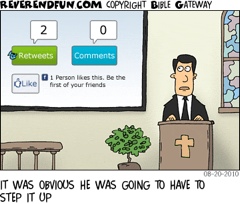Preaching is a form of communication where it is difficult for the preacher to utilize any feedback given from the congregation. With a single sermon there are as many opinions as there are listeners-sometimes more!
With my own sermons, I realize that not every one is going to be a home run. But often, when I think one is terrible, someone will inevitably tell me how they experienced renewed faith though it.
In seminary I was taught by Dr. Clay Scmit the 5 things that make a faithful sermon. I try to keep these in mind while I am thinking, writing, practicing, re-writing, and further practicing the sermon. These points help me craft a faithful sermon.
A sermon should:
- Be faithful to the text: A sermon should come from the Bible. It shouldn’t come from the latest theological book, the church’s confessions, or whatever happens to be on the preachers mind. The primary source for faithful preaching is the scriptures, a preacher should be deeply engaged with the written Word.
- Be faithful to the context: A sermon is for a specific time and place. A preacher should know the people in the congregation well enough that the sermon speaks to them specifically. A sermon given in an urban nursing home will be different than one give in a suburban church service–even if the scripture used is exactly the same. This is why no preacher should ever take whole sermons from the internet-they are not written for your congregation.
- Faithful in Theology: A sermon should not stray from the theological history of a specific theological tradition. This means that a sermon on the Eucharist is going to be different in a Lutheran church then it would be in a Nazarene church. Additionally, the sermon should always tell some part of the Good News God’s grace in Jesus Christ.
- Touch the mind: A sermon should be clear and logical. It should cause the listener to think more about the scripture, God, and life or inspire points of further reflection.
- Touch the heart: A sermon should not bore the listener. A faithful sermon is crafted like a piece of art that engages the hearer through the use of effective communication techniques-stories, repetition, eye contact, appropriate gestures, repetition. It should be “entertaining.” (I know some people will have a problem with my use of this word).
Though I’m mindful of these points, a sermon is more like art then assembly; just because I know them doesn’t make the writing any easier.
I have thought for many years about what I would add to this list. But every time I come up with something, I realize that it falls under one of the above categories.
I find what I have learned here is substantive and worthy of use and further reflection.
Is there anything you would add to this list?
-jpserrano
It wasn’t until I picked up one of his books that I realized he wrote this stuff down. If you are interest in reading the book where he wrote these points down and elaborates on them I recommend Sent and Gathered: A Worship Manual for the Missional Church (Engaging Worship) along with any of his other works.
You can find them here:

